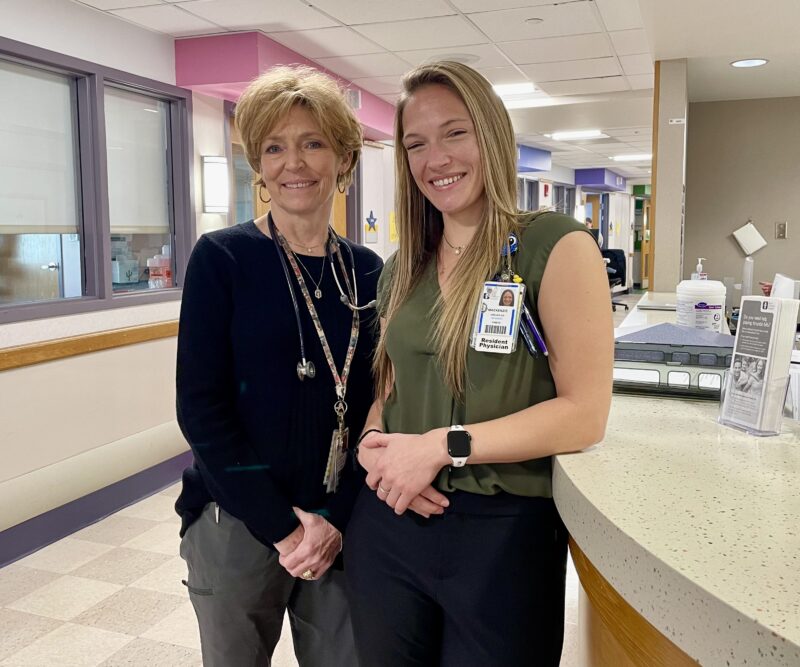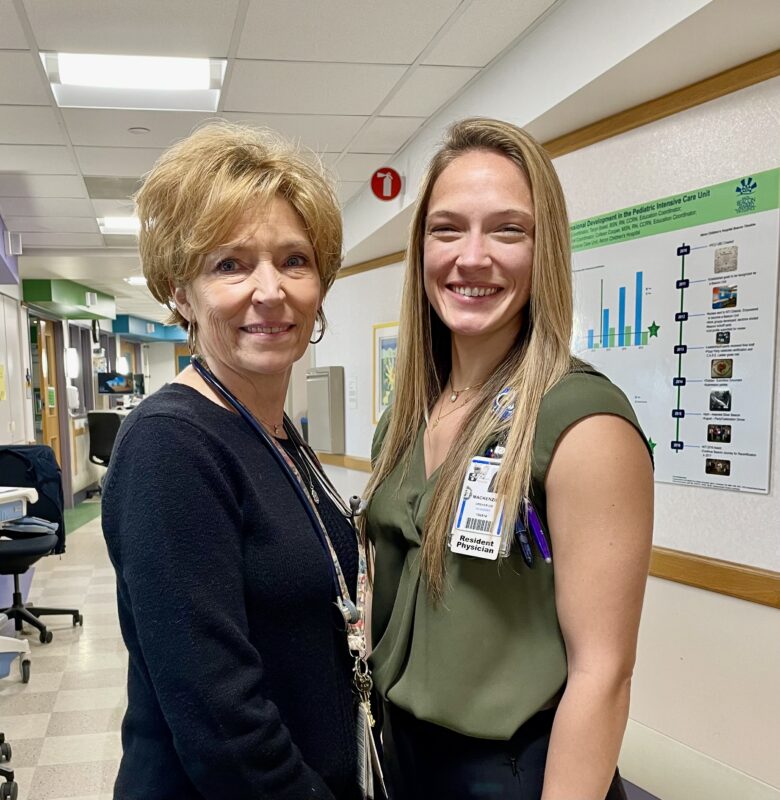
Cathleen Tichy-Dreher, CNP, and Mackenzie Dreher, M.D., in Akron Children’s PICU.
When Cathleen Tichy-Dreher, known to all as “Tichy,” a nurse practitioner with more than 4 decades of experience in pediatric critical care, joined Akron Children’s PICU in 2019, she noticed that the nurse practitioners and the medical residents in the unit were not working as collegially as she had experienced at her previous hospitals.
Advance practice providers (APPs) and residents often do many of the same roles in patient care and communication could be better, she thought. She mentioned this to Dr. John Pope, director of medical education and a long-time pediatric intensivist. He encouraged her to take her concerns on as a quality improvement project.
About a year after the study was underway, Tichy had a bit of a personal/professional curveball thrown her way.
Her daughter, Dr. Mackenzie Dreher began working in her PICU as a pediatrics resident.
Tichy said she took PTO the first week of Mackenzie’s arrival in the unit, because she was so nervous about the situation.
“I didn’t want anyone to know we were related,” she admitted. “I wanted to see how she interacted; they interacted. I didn’t want any negativity, and I didn’t want too much of a positive if they knew me. I didn’t want special treatment [for her].”
Mackenzie’s onboarding went smoothly and once settled, she jumped at the opportunity to join her mother on the study.
“This felt important to me, because I am going onto a PICU fellowship,” said Mackenzie. “But it’s important for everyone to get a good learning experience.”
The study group expanded to include other APPs, residents, including the chief residents, and attending physicians. Their SMART Aim: Improve the rotation experience for all PICU residents in communications and learning opportunities by receiving scores of 4 or greater on the Likert Scale by December 31, 2023.
The team identified ideas that would make residents feel more involved, more hands-on rather than bystanders.
Nurses tend to go to APPs with their questions, because they are “in house,” so to speak, and APPs are often eager to start a procedure without a resident in the quick pace of a critical care unit.
One idea the team had was to create a VOALTE group texting system for each PICU patient, connecting his or her APP, nurse, resident and respiratory therapist.
“It’s taken my colleagues a few weeks, months to not be the first ones to answer questions in these group texts,” said Tichy, “but it has, over time, empowered the pediatric residents more in their decision making.”
The researchers looked at ACGME mirrored surveys and tweaked their own surveys, recognizing the importance of anonymity in getting honest feedback.
Other interventions included Dr. Ryan Nofziger‘s suggestion to add a Google Classroom orientation to discuss expectations for PICU rotations lead by chief residents and having the chief and senior residents reach out to new residents during their first week and, again, mid-rotation.
The current working title for the research is “Focus Group: Impact of Learners/APPs in the PICU: Improving Resident Satisfaction During PICU Rotation.”
Tichy and Mackenzie did a poster presentation of their work during Akron Children’s “Quality Improvement Week,” but the team is still collecting data and probably two years out from publication.
The mother/daughter believe the research has universal application. Based on a literature review she did, Mackenzie found the issue to be widespread at hospitals and not just in PICUs.
Not to get ahead of their data but Mackenzie said she sees comments in the surveys that suggests they are making changes for the good. One resident wrote, “I’ve seen a change in my three years from being an intern in here and not being able to do a lot to now being able to essentially take over the care of the patient having an APP as a teammate.”
“It’s definitely changed the dynamic in the unit,” said Tichy. “It’s ongoing. It’s not perfect by any means but it has improved the relationships, the care of the patient, and comfort of the nurses with the residents.”

Working Together
Once they both got over the awkwardness of their first weeks, Tichy and Mackenzie have loved and appreciated the rare experience they have had of working together for about 12 weeks in the PICU.
Tichy expressed pride in her daughter’s professionalism, citing her reputation around the hospital for excellent patient care, even with the most acute patients.
Meanwhile, Mackenzie clearly emulates her mother’s skills when it comes to completing medical procedures with speed and perfection.
“Her mother,” said Mackenzie, referring to her maternal grandmother, “was a phenomenal seamstress and she picked up those skills – the dexterity she has – putting in lines – is incredible. I would like to say I have some of it.”
“You’re getting there,” added Tichy.
Tichy has picked up valuable tips from Mackenzie when it comes to research protocols and even tech skills like creating graphs and charts for their final publication.
“My mom and I are very close and we talk every day,” said Mackenzie. “I moved away for college and medical school, but working together has been amazing. I’ve gotten to learn so many things from her beyond what I ever thought I could pick up just observing.”
Mackenzie will leave in July for her three-year pediatric critical care fellowship at Children’s Mercy in Kansas City.
In addition to Tichy and Mackenzie, the other study authors include pediatric critical care physicians Drs. John Pope and Ryan Nofziger; PICU nurse practitioners Beth Forst, Kerri Clark, Tammy Camelli, and Danielle Standohar; and pediatric residents Drs. Paige Daily, Amy Buck, and Lalan Shah.











